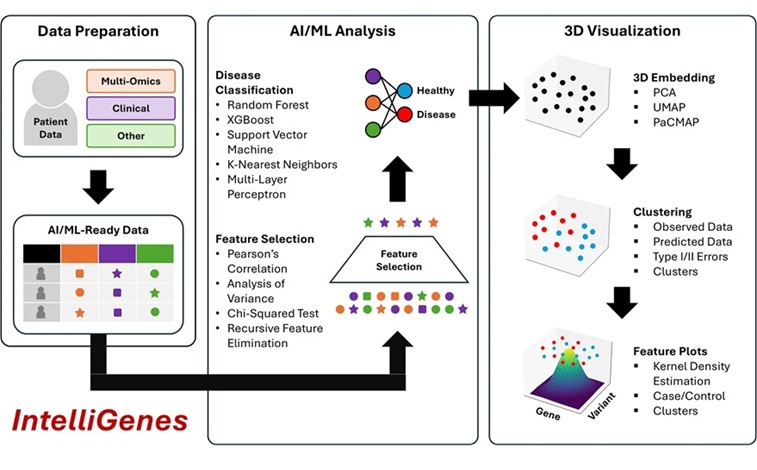AI Platform Uses 3D Visualization to Reveal Disease Biomarkers in Multiomics Data
Posted on 28 Aug 2025
The ability to visualize health data in three dimensions can reveal patterns and relationships among predictive biomarkers that conventional methods cannot. Biomarkers play a critical role in early diagnosis and personalized treatment, yet their complexity across multiomics data often makes analysis difficult. By introducing advanced visualization techniques, scientists can better interpret disease risks and treatment pathways in a more accessible and intuitive way. Now, researchers have developed an innovative solution to better visualize results produced by artificial intelligence/machine learning (AI/ML) approaches on integrated clinical and multi-omics data for novel biomarker discovery and predictive analysis.
3D IntelliGenes, developed by researchers at Rutgers University-New Brunswick (New Brunswick, NJ, USA), is an open-source AI/ML platform designed for multiomics data visualization. The software is optimized for standard desktops and available across Windows, macOS, and Linux, making it accessible to scientists from diverse bioinformatic backgrounds. It enables users to visually analyze large-scale biological and clinical datasets in a way that highlights subtle but important biomarker interactions.

In their study published in BMC Medical Research Methodology, the researchers have described the platform, representing the first detailed demonstration of how 3D visualization can integrate and interpret complex multiomics data. By building a comprehensive workflow, the researchers showed that the system can generate visual graphs mapping biomarker relationships, enabling scientists to detect disease-related signals more effectively than with standard approaches.
The platform’s applications extend well beyond research. It could support earlier diagnosis of diseases, improve the accuracy of biomarker discovery, and advance personalized medicine by tailoring treatments based on patient-specific molecular signatures. With further clinical integration, the technology could be adapted to detect disease indicators such as cardiovascular markers or cancer-specific changes, potentially influencing treatment strategies worldwide.
“Our goal is for multiomics data to become more accessible to the wider scientific community so researchers can better understand diseases and their treatments,” said Zeeshan Ahmed, who led the research team that developed 3D IntelliGenes. “For example, the software could produce visual graphs showing relationships between biomarkers, such as cardiovascular disease indicators, which could help researchers and clinicians analyze and interpret heart health and disease risks more effectively.”
Related Links:
Rutgers University-New Brunswick









 Analyzer.jpg)



